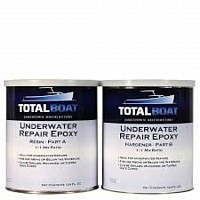Underwater materials
Used of Epoxy
TIPS FOR EPOXY RESIN MIX PREPARATION
Do all your prep work first. Think through the entire process before you start.
Get your substrate ready and only then start your epoxy resin mix.
Epoxy resin mix, application, and clean-up should always be the last step in the process as it requires the most attention.
If it’s your first time using an epoxy resin mix, do some sample mixes to get comfortable with the curing times and how the physical properties change throughout the kicking process and pot-life.
You’ll know the resin is about to kick when the pot warms up, and the consistency begins to thicken.
On high-gloss surfaces be sure to sand the surface with minimum 150 grit to ensure good mechanical adhesion.
Because there are no solvents in Entropy’s Epoxy Resins, a good mechanical bond is 100% necessary. And always remember to clean the surface thoroughly, before mixing the epoxy resin.
Clean your new brush using tape (sticky side) before mixing your epoxy. This will remove any loose fibers from your brush and require less clean-up before the epoxy kicks.
For high-quality finish jobs, we recommend a 3” synthetic bristle brush. If sanding is required, then a standard chip brush will work fine. For finish coats, use a better brush.
Warm resin wets out better and cures faster.
Avoid storing your epoxy and hardeners in very cold temperatures, this will change the viscosity of the resin. Also, be aware that constant heating of the epoxy can cause condensation and/or contamination.
If necessary, warm your epoxy resin by storing it above a heater.
Hardener, on the other hand, should always be maintained at room temperature as heating uncured hardener can cause amberization.
TIPS FOR EPOXY RESIN MIX APPLICATION
Ambient cure epoxies such as CLR and CCR by Entropy Resins, are greatly affected by temperature and humidity.
Avoid applying epoxy resins for laminating and hot-coating outside in cold temperatures, on surfaces with condensation or high-humidity days.
For faster kicks let the epoxy resin mix sit for a few minutes before pouring. As the mixture heats, the curing times will accelerate.
This is a good trick for laminating vertical surfaces where running or dripping is a concern, or if you are applying in less than ideal temperatures.
If heat is an issue, try using a slower kicking resin or slow down the kicking process using ice-packs wrapped in a zip-lock bag to cool the resin system. This is a common trick for installing components where a void is to be filled using epoxy.
Do not allow quantities larger than 3 ounces to kick in the pot, this can cause an exothermic reaction which will off-gas.
In extreme cases (gallon +) exotherm can cause epoxy and hardeners to combust due to the amount of heat released.
Even with very thick applications, this isn’t a concern, but excess material left in the pot should be poured out to kick or the pot should be moved outside into an openly ventilated area.
Note: Cured epoxy waste is not considered hazardous materials. Un-kicked resin and hardener should be disposed of properly.
Consider spreading a very thin layer of mixed epoxy with a squeegee first and then smoothing out the finish using a brush. This will spread the resin easier over larger areas.
If more epoxy resin is required, or there are issues with settling, wait until the resin has begun to tack and apply a thin second coat or fill low spots using a new batch of resin, (30 minutes after first application).
For the best application, apply epoxy in a criss-cross pattern and then allow it to settle before it kicks.
TIPS FOR EXPOSY RESIN MIX CURING & CLEAN UP
Always stay with the project until it has begun to tack and cure. Surface contamination can cause fish-eyes or low spots on any project.
If you don’t have time to monitor the curing, then it is best to leave it for another day.
If the epoxy cure time is too fast, use a slower Resin. If it’s too slow, use a faster hardener.
The general-use CLR Epoxy system comes in Fast, Slow and Extra Fast cure times.
Custom hardeners can be created by mixing different speeds of hardeners systems to meet your requirements.
Allow the epoxy to cure at room temperature.
If trimming is required, aim to cut or pull tape approximately 1-2 hours after the resin has begun to set. Trimming epoxy and fiberglass when 75% cured is much easier than once completely cured.
Once fully cured, sanding and mechanical removal are required.
Once dripping and running has ceased, edging tape can be removed. Good quality 3M tape and painters tape are highly recommended.
Clean-up using denatured alcohol, not acetone. As a general precaution avoid using solvents in your workspace.
Squeegees are easiest to clean once the epoxy is fully hardened (overnight). Brushes are single use unless you have access to a freezer, in which case the brush can be kept for touch-ups. Beware that once it warms to room temperature, it will kick.
If you get any on your skin remove it immediately with a solution of warm soap and water.
Now you are ready to start your project. Remember to check the safe use guides, safe handling information and technical data sheets that come with your epoxy system before mixing.
Now that you know the best tips and tricks for a great epoxy resin mix check out our Tutorial on Step-by Step Guide: Measuring and Mixing Epoxy Resins or our resins and solvent experiments





